finalexam finc 460
1/169
There's no tags or description
Looks like no tags are added yet.
Name | Mastery | Learn | Test | Matching | Spaced |
|---|
No study sessions yet.
170 Terms
What is FinTech?
Technological innovation in the way that capital is transferred, borrowed, or invested (checks, ATM, online banking, Robinhood, etc.)
Issues with the current banking system
Opaque
Inefficient
Centralized Control
Limited Access
Lack of Interoperability
Opacity
Current financial system is not transparent
We do not understand many underlying risks of banks
Bank trust is a function of regulation and gov’t backstops (FDIC insurance)
Inefficiency
Transactions are expensive (3% credit swipe)
Transactions take a long time (t+1, slow fund transfer, fraud, chargebacks, insecurity)
Centralized Control
Central Banks control currency (inflation, interest rates)
banking system is concentrated
Limited Access
7.1 million (5.4%) households in the US are unbanked
2 billion people in the world are unbanked
Entrepreneurs cant get smaller loans
Interoperability
Hard to move money and securities from one financial institution to another
How did Fintech 1.0 begin
transatlantic cable laid between London and New York
How did Fintech 2.0 begin
computer revolution, ATM, PC, mobile phone
How did Fintech 3.0 begin
underserved retail and small business customers, P2P platforms launched as well
Sample of FinTechs
M-Pesa (digital banking)
Wise Financial (payments)
Kickstarter (crowdfunding)
Lending Club (P2P lending)
Wealthfront (RoboAdvisor)
Robinhood (Trading)
T.F: Bitcoin ≠ Blockchain?
TRUE
Open Ledger

Distributed Ledger
No central authority to hold ledger or be attacked. All people (aka nodes) have complete ledger.
Could store:
Financial Transactions
Property Records
Shipments and Inventory
Grades
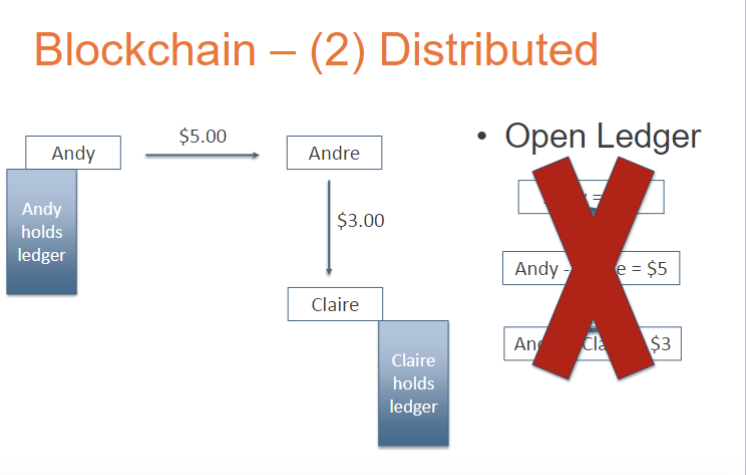
Miners
Miners group the transactions together (i.e. a “block”) and take a hash of the transactions plus an arbitrary number – the “nonce”
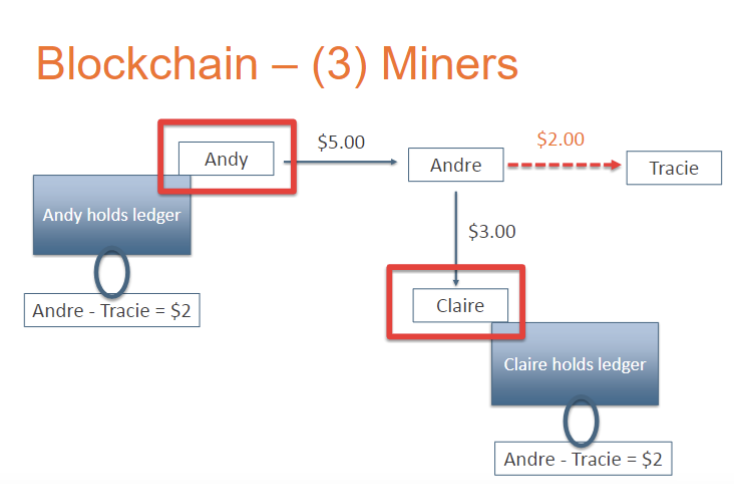
Transparent but anonymous ledger
ledger can be public while concealing identity
Append only ledger
Each entry (aka block) is linked to the previous entry via some math (aka hash)
Some nodes (aka miners) are paid for performing calculations (aka proof of work)
Immutable Ledger
Attacks to ledger are impractical due to need for majority of nodes (aka 51% attack) to agree to a change and the computational power required
Blockchain is technology
Many different blockchains (not just one)
data added is packaged into “blocks”
“blocks” are “chained” together cryptographically to allow an audit of prior history
Blockchain Transparency
The balance of all public keys are transparent (primary characteristic of blockchain)
Blockchain mechanics
Bitcoin blocks occur every 10 minutes
Last line over every block contains a hash
Last line (the hash) is repeated as the first line in the next line. This is why it is called “chain”. Altering any data in say block 1, means the last line will change and will not match the first line in block 2.
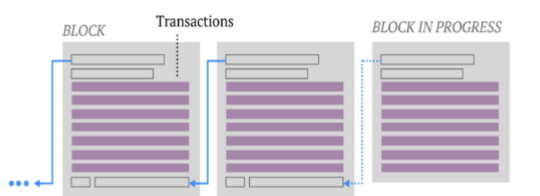
Hashing
SHA-256 (secure hashing algorithm) (256 bits no matter the input)
a primer
encodes a message
one way function
Nonce
Arbitrary number added to the hash of transactions
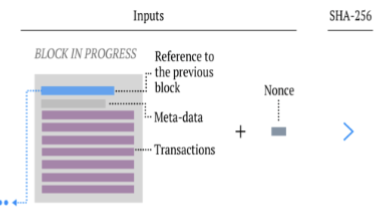
Proof of Work - Miners
Miners must guess a “nonce” that (along with the transaction data in the block) produces a hash with many leading zeros.
The current requirement for Bitcoin miners is 17 leading zeros.
The probability of guessing this a nonce that satisfies this requirement is (1/16)^17
Proof of Work machines
The Antminer S17 does 53 trillion hashes per second
often work in groups or networks
winning miner/network of miners receives 3.125 new bitcoin.
This cuts in half every 210,000 blocks or 4 years
Proof of Work benefits
extremely secure
The amount of work required to produce so many leading zeros mean that it is almost impossible for a bad actor (hacker or even country) to change a historical block
Proof of Work downsides
PoW mining is a wasteful activity, as the many nodes searching for the hash consume electricity
At year-end 2022 was estimated at 73 terawatt-hours, or the equivalent annual electricity usage of Austria.
At year-end 2023, it was 138 TWh equivalent to Ukraine.

Proof of Stake
PoS does not require mining to verify transactions. Instead, a holder of a given cryptocurrency must deposit or “stake” cryptocurrency with the network to be entered into a pool of validators.
Validators are randomly chosen to verify transactions and receive the block reward, with the probability linked to the amount of cryptocurrency they have staked.
A validator that verifies (or attests) malicious blocks loses their stake as a penalty.
In September 2022, the Ethereum network completed its transition from PoW to PoS, reducing its energy consumption by 99.95%
What makes bitcoin favorable to become a fiat currency
decentralized
not controlled by a central bank
accessible by individuals in most nations
Barter
peer-to-peer
inefficient (need to find exact match for trade)
evolution of money
rai stones
gold
fiat money
crypto?
First implementation of a cryptocurrency
Satoshi Nakamoto in 2009 created Bitcoin
Characteristics of money
Unit of account: way to compare value of different goods
Medium of exchange: non-barter transactions
store of value: allows value to be retained rather than decay (storing food
Issues with (fiat) money
inflation
bank runs
central bank issues, etc.
Hyper-inflation
a severe and rapid increase in the price of goods and services, which causes the value of a country's currency to decrease
Example: Zimbabwe 2007-2008 had a daily inflation rate of 98% (had signs to not use it as toilet paper)
Bank run examples
People attempt to withdraw a lot of money at same time and bank doesn’t have enough on hand. Silicon Valley Bank, Ghana, Afghanistan
Cryptocurrency can function as:
medium of exchange
contractual right to transact (e.g., use a service)
vote on governance
financial security providing cash flow claims
Unique claim (NFT) – e.g., ar
The unifying theme across coins/tokens is
distributed ledger technology (e.g., blockchain) on which the digital asset is secured and transactions are verified
Bitcoin
Satoshi’s motivation was to create a currency not controlled by a central authority
peer-to-peer version of electronic cash would allow payments to be sent directly from one party to another without going through a central intermediary such as a central bank
Ownership of bitcoins is recorded in an electronic distributed ledger called the blockchain
Blockchain
Distributed ledger where transactions are batch processed in blocks and secured using cryptography in an immutable, append-only, public ledger
What problems does bitcoin solve?
eliminates intermediaries
solves the “double spend” problem
The double-spend problem
Earlier digital currencies failed as no one could solve the “double-spend” problem: how to allow for the electronic exchange of money without a trusted intermediary to verify that the money had not be spent twice.
How did bitcoin solve the double-spend problem
Satoshi’s solution was to use a time-stamped electronic record-keeping system to record transfers of bitcoins.
This electronic ledger [blockchain] was secured against alterations using cryptography.
The blockchain would remain public and transparent, with multiple copies widely available on a P2P network run on independent computers (called nodes).
Bitcoin rules
maximum of 21 million bitcoins
maximum size of a block is 1 megabyte
transactions are batched processed with 1 block added every 10 minutes
Mining using proof of work
Only the owner can spend – verification by private key
Infinitely small probability of successful “hack”
Bitcoin Volatility
Extremely volatile. goes from 20k to 3k to 68k to 20k to 60k
Intrinsic Value - Iraqi Swiss Dinar
The Iraqi Swiss dinar was the currency of Iraq until the first Gulf War
The name derives from the fact that the plates to make the currency were produced in Switzerland and notes printed in the UK
In 1991, Iraq split in two - Saddam Hussein controlled the south and the Kurds controlled the north
Because of sanctions, Iraq could not import Swiss dinars - so Saddam ordered the printing of a new currency
May 1993 - Central Bank of Iraq declares citizens have three weeks to
exchange old 25 dinar notes for new ones
The Iraqi Swiss dinar had no official backing - yet it was accepted as money. Reason: because people were willing to accept it as money
USD demand comes from
taxes
purchase of goods denominated in USD
repayment of debt in USD
US economic expansions and contractions impact value
Central Bank (i.e., Federal Reserve) has the ability to inflate
Arbitrage
Arbitrage opportunities across exchanges have been large, profitable, and recurring despite the introduction of futures and margin trading.
Price deviations increase as the Bitcoin price rises, and during unusual events (following hacks and breaches of exchanges).
Bitcoin traders may not take advantage of these arbitrage profits due to a lack of capital and sophistication
Kimchi Premium - price of bitcoin in South Korea allowed for arbitrage
Bitcoin a fraud?
JPM Jamie Dimon calls bitcoin a fraud then “regrets calling it a fraud”
Bitcoin illegal activity
using the website silk road people purchased illegal items such as drugs and weapons using bitcoin
3.36 Billion cryptocurrency seizure and conviction in connection with silk road dark web fraud
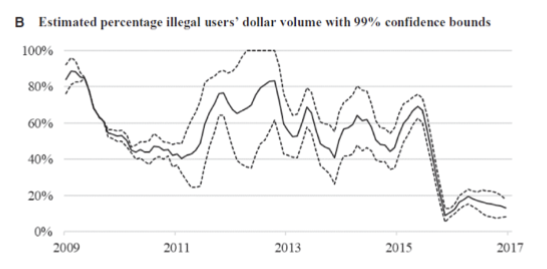
Transaction Fees (Bitcoin)
no fees to process transactions
unverified transactions wait their turn to be processed in the memory pool “mempool”
however, senders wanting quicker confirmation can pay a voluntary fee to incentivize miners to pick them first
Miners choose transactions offering the highest fee-to-size ratio to maximize the fee for each block.
This fee is known as the “feerate” and is measured in Satoshi-per-byte, where 1 bitcoin is divisible into 100,000 Satoshis
Private Keys
When a token is transferred, the sender uses a digital signature algorithm to sign the token over to someone else’s address. The signature mathematically reveals that the sender has the private key associated with the sender’s public address
Private Key Issue
Around 20% of bitcoin appears to be lost due to people losing or stranding their digital wallets
Hard Forks
When the holders of a cryptocurrency disagree and vote to split, it can lead to the creation of a new digital coin with a similar name.
A new blockchain is created to verify new transactions; these new coins are no longer recognized as valid by the original blockchain.
Both coins share the same transaction history up to the fork
T/F: Bitcoin has hard forked?
TRUE
Bitcoin Fork
Bitcoin Cash forked on Aug 1 2017 at block 478,558 on the Bitcoin blockchain.
The hard fork was in response to Segregated Witness (SegWit), which aimed to increase processing speed.
Bitcoin Cash introduced larger block size up to 8M, requiring a more complex mining process that favored large miners with more computing power.
Bitcoin alternatives
23,000+ tokens, coins, and other crypto assets with a total market cap of 1.65T
Stablecoins
tokens backed by:
fiat currencies (e.g. U.S. dollar)
commodities (gold, oil)
other cryptocurrencies, or nothing at all (algo stables)
Ether (ETH)
most innovative and transformational cryptocurrency. It is the token used to run decentralized applications (dapps) on the Ethereum blockchain
Crypto can be traded…
24/7 over 400 exchanges
coinbase is centralized or decentralized
centralized
T/F: Francis Suarez, the mayor of Miami is pushing for crypto
TRUE
Ethereum
started by Vitalik Buterin in 2015
It is the foundation for decentralized finance (DeFI)
ethereum blockchain is more like an open-source platform where developers can build
decentralized applications (dApps)
create smart contracts
launch new tokens
Decentralized Finance (DeFi)
a global, decentralized financial system based on crypto assets, blockchains, and smart contracts
Ethereum use cases
savings account, P2P gambling, financial derivates, and new cryptocurrencies
T/F: ETH has a limit on how many can be created
FALSE
Smart contracts
code that can create and transform arbitrary data or tokens on top of the blockchain
allows the user to trustlessly encode rules for any type of transaction
many standard business contracts can be algorithmically encoded and algorithmically enforced
contracts run on the Ethereum blockchain
Example of an original “smart contract”
vending machines
Gas for Ethereum
Coding and hosting a dapp on ethereum is free
running a dapp has a gas fee (paid in ETH)
The amount of gas depends on the computational resources required to run a program. Promotes efficient coding
Until September 2022, ETH verified transactions using proof-of-work (PoW) just like Bitcoin. It used Ethash for hashing and was computationally demanding algorithm. Blocks were verified every 12 seconds… but now it uses ______________
proof-of-stake
Ethereum proof-of-stake benefits
reduced energy consumption by 99.95%
Who created ERC-20, and why?
Ethereum developer created it
standardize all fungible tokens using smart contracts to increase interchangeability
What does ERC-20 mean
Ethereum Request for comment-20
ERC-20
the most popular standard for “fungible tokens” – i.e., tokens that have identical utility and functionality.
Tether (USDT), Shiba Inu (SHIB), and Chainlink (LINK) are all ERC-20. Our GBO token is ERC-20
Monetary example – US dollars are “fungible”. Two different $1 bills have the same value. Five $1 bills have the same value as a $5 bill
Benefit of ERC-20
The benefit of these standards is that application developers can code for one interface and support every possible token that implements that interface.
T/F: Any application (i.e., smart contract) that can generically handle ERC-20 functionality can handle any ERC-20 token (even tokens that do not yet exist!!)
TRUE
ERC-20 Token types
Payment token
stablecoins are a special case
Utility Tokens
Security Tokens (aka equity tokens)
Governance Tokens
Payment tokens
used as money to buy things online
cryptocurrencies are payment tokens
most payment coins are very volatile. Stablecoins emerged as a special case
T/F: Bitcoin and ethereum do not comply with ERC-20 programming protocols
TRUE
What emerged due to BTC and ETH not complying with ERC-20
“wrapped” BTC and ETH
Stablecoins
maintain price parity with some target asset (USD, Gold)
provide stability and allow investors to participate in many smart contracts and DeFi applications
types of stablecoins
fiat collateralized
crypto collateralized
algorithmic
Stablecoins - Fiat Collateralized (give examples)
backed by an off-chain reserve of target asset (USD, Gold)
Ex: Tether, USDC (both centralized)
Stablecoins - Crypto Collateralized (give examples)
MakerDAO - DAI is the most popular crypto collateralized stablecoin (backed by ETH)
sUSD - linked to the Synthetix, backed by SNX network token
Stablecoins - Algorithmic (give examples)
not backed by an underlying asset
uses algorithmic expansion and contraction of supply to shift the price to the peg
Token holders in the platform receive the increase in supply when demand increases.
When demand decreases and the price slips below the peg, these platforms would issue bonds of some form which entitle the holder to future expansionary supply before the token holders receive their share
Example: Terra/Luna
Stablecoins - Terra and Luna
a blockchain with its own governance token, LUNA, linked to algorithmic stablecoin TerraUSD (UST)
backed by LUNA. algorithm automatically adjusting UST supply to keep price at $1
Collapsed in May 2022. It was a Ponzi Scheme
Ponzi Scheme
A type of investment fraud that promises high returns with little risk to investors. It pays returns to earlier investors using the capital from new investors, rather than from profit earned by the operation of a legitimate business. Eventually, it collapses when the operator can no longer attract enough new investors to pay returns.
ERC-20 Utility Tokens
Fungible tokens that are required to utilize some smart contract system
It is possible for these tokens to have an intrinsic value (proposition) that is defined by its smart contract system
ERC-20 - Utility token use cases
pay application-specific fees (FILE, DAI, LINK)
to be collateral (SNX)
ERC-20 - Security/Equity Token
represents ownership of an underlying asset or pool of assets
each corresponds to an identical share in the pool
Example: suppose a token, TKN, has a total fixed supply of 10,000, and TKN corresponds to an ETH pool of 100 ETH (held in asmart contract).
The smart contract stipulates that for every 1 token of TKN it receives, it will return a pro rata amount of ETH. Fixing the exchange ratio at 100 TKN = 1 ETH
Equity Tokens other examples
Compound: Variable interest-rate mechanics
Uniswap: Contract that owns a multi-asset pool with a complex fee structure
Set Protocol: A standard interface for creating equity tokens with static or dynamic holdings
Governance Tokens
similar to equity tokens as they represent percentage ownership
Applies to voting rights
many smart contracts have embedded clauses stipulating how the system can change. These changes include
adjusting parameters
adding new componets
altering the functionality of existing components
Purpose of governance tokens
A contract without the capacity for change is rigid, however, and has no way to adapt to bugs in the code or changing economic or technical conditions.
For this reason, many platforms strive for a decentralized upgrade process, often mediated by a governance token.
Examples of Governance tokens
can be implemented in many ways: static, inflationary, deflationary supply
MKR - static supply
COMP - inflationary supply
ERC-721 is ________
the standard for “non-fungible tokens) - NFTS. These unique tokens are used as unique claims (bored ape)
ERC-721: NFT
non-fungible token
started with crypto kitties
unique digital code that is secured and stored on a public blockchain
one token is not interchangeable with another
cannot be further divided
most NFTs are currently deployed as ERC-721 non-fungible tokens on Ethereum
Highest sold NFT price
$69 million USD
$69 million NFT. What did the auction winner buy as the NFT does not confer exclusive access to the digital art or any royalty income
bragging rights?
the NFT procides a disintermediated, secure ownership record that is recorded (immutable) on the Ethereum blockchain
Example of something that is nonfungible
lottery tickets (non-winners are useless)
Ethereum transactions
Transactions involve sending data or ETH (or other tokens) from one address to another
An Ethereum user can control addresses through an externally owned account (EOA) or by using smart contract code (contract account)
When sending data to a contract account, the data are used to execute code in that contract. The transaction may or may not have an accompanying ETH payment for use by the contract